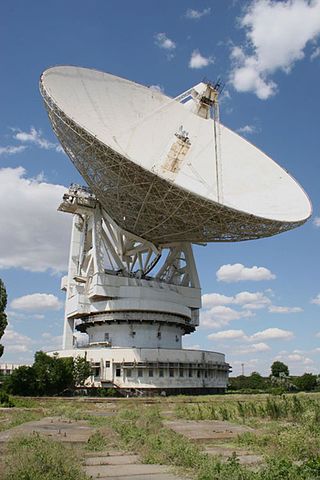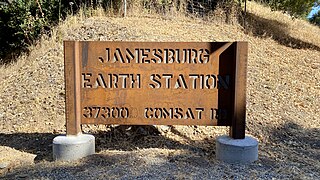
The Fermi paradox is the discrepancy between the lack of conclusive evidence of advanced extraterrestrial life and the apparently high likelihood of its existence. As a 2015 article put it, "If life is so easy, someone from somewhere must have come calling by now."
The search for extraterrestrial intelligence (SETI) is a collective term for scientific searches for intelligent extraterrestrial life, for example, monitoring electromagnetic radiation for signs of transmissions from civilizations on other planets.

Frank Donald Drake was an American astrophysicist and astrobiologist.
Extraterrestrial intelligence, or non-human intelligence, refers to hypothetical intelligent extraterrestrial life. No such life has ever been proven to exist in the Solar System except for humans on Earth, and its existence on other star systems is still speculative. The question of whether other inhabited worlds might exist has been debated since ancient times. The modern form of the concept emerged when the Copernican Revolution demonstrated that the Earth was a planet revolving around the Sun, and other planets were, conversely, other worlds. The question of whether other inhabited planets or moons exist was a natural consequence of this new understanding. It has become one of the most speculative questions in science and is a central theme of science fiction and popular culture.

The SETI Institute is a not-for-profit research organization incorporated in 1984 whose mission is to explore, understand, and explain the origin and nature of life in the universe, and to use this knowledge to inspire and guide present and future generations, sharing knowledge with the public, the press, and the government. SETI stands for the "search for extraterrestrial intelligence".

The Wow! signal was a strong narrowband radio signal detected on August 15, 1977, by Ohio State University's Big Ear radio telescope in the United States, then used to support the search for extraterrestrial intelligence. The signal appeared to come from the direction of the constellation Sagittarius and bore expected hallmarks of extraterrestrial origin.
The Great Filter is the idea that in the development of life from the earliest stages of abiogenesis to reaching the highest levels of development on the Kardashev scale, there is a barrier to development that makes detectable extraterrestrial life exceedingly rare. The Great Filter is one possible resolution of the Fermi paradox.

The communication with extraterrestrial intelligence (CETI) is a branch of the search for extraterrestrial intelligence (SETI) that focuses on composing and deciphering interstellar messages that theoretically could be understood by another technological civilization. The best-known CETI experiment of its kind was the 1974 Arecibo message composed by Frank Drake.

The Teen Age Message (TAM) was a series of interstellar radio transmissions sent from the Yevpatoria Planetary Radar to six solar-type stars during August–September 2001. The structure of the TAM was suggested by Alexander Zaitsev, Chief Scientist at Russia's Institute of Radio-engineering and Electronics. The message's content and target stars were selected by a group of teens from four Russian cities, who collaborated in person and via the Internet. Each transmission comprised three sections: a sounding, a live theremin concert, and digital data including images and text. TAM was humanity's fourth Active SETI broadcast and the first musical interstellar radio message.
Active SETI is the attempt to send messages to intelligent extraterrestrial life. Active SETI messages are predominantly sent in the form of radio signals. Physical messages like that of the Pioneer plaque may also be considered an active SETI message. Active SETI is also known as METI.

The Jamesburg Earth Station is located in the rural Cachagua area of Carmel Valley, California, about 26 miles (42 km) southeast of Monterey. It was originally built in 1968 to support the Apollo 11 Moon landing.
A post-detection policy (PDP), also known as a post-detection protocol, is a set of structured rules, standards, guidelines, or actions that governmental or other organizational entities plan to follow for the "detection, analysis, verification, announcement, and response to" confirmed signals from extraterrestrial civilizations. Though no PDPs have been formally and openly adopted by any governmental entity, there is significant work being done by scientists and nongovernmental organizations to develop cohesive plans of action to utilize in the event of detection. The most popular and well known of these is the "Declaration of Principles Concerning Activities Following the Detection of Extraterrestrial Intelligence", which was developed by the International Academy of Astronautics (IAA), with the support of the International Institute of Space Law. The theories of PDPs constitute a distinct area of research but draw heavily from the fields of SETI, METI, and CETI.
The cultural impact of extraterrestrial contact is the corpus of changes to terrestrial science, technology, religion, politics, and ecosystems resulting from contact with an extraterrestrial civilization. This concept is closely related to the search for extraterrestrial intelligence (SETI), which attempts to locate intelligent life as opposed to analyzing the implications of contact with that life.

Technosignature or technomarker is any measurable property or effect that provides scientific evidence of past or present technology. Technosignatures are analogous to biosignatures, which signal the presence of life, whether intelligent or not. Some authors prefer to exclude radio transmissions from the definition, but such restrictive usage is not widespread. Jill Tarter has proposed that the search for extraterrestrial intelligence (SETI) be renamed "the search for technosignatures". Various types of technosignatures, such as radiation leakage from megascale astroengineering installations such as Dyson spheres, the light from an extraterrestrial ecumenopolis, or Shkadov thrusters with the power to alter the orbits of stars around the Galactic Center, may be detectable with hypertelescopes. Some examples of technosignatures are described in Paul Davies's 2010 book The Eerie Silence, although the terms "technosignature" and "technomarker" do not appear in the book.
Breakthrough Initiatives is a science-based program founded in 2015 and funded by Julia and Yuri Milner, also of Breakthrough Prize, to search for extraterrestrial intelligence over a span of at least 10 years. The program is divided into multiple projects. Breakthrough Listen will comprise an effort to search over 1,000,000 stars for artificial radio or laser signals. A parallel project called Breakthrough Message is an effort to create a message "representative of humanity and planet Earth". The project Breakthrough Starshot, co-founded with Mark Zuckerberg, aims to send a swarm of probes to the nearest star at about 20% the speed of light. The project Breakthrough Watch aims to identify and characterize Earth-sized, rocky planets around Alpha Centauri and other stars within 20 light years of Earth. Breakthrough plans to send a mission to Saturn's moon Enceladus, in search for life in its warm ocean, and in 2018 signed a partnership agreement with NASA for the project.
METI International, known simply as METI, is a non-profit research organization founded in July 2015 by Douglas Vakoch that creates and transmits interstellar messages to attempt to communicate with extraterrestrial civilizations. It is based in San Francisco, California.

Douglas A. Vakoch is an American astrobiologist, search for extraterrestrial intelligence (SETI) researcher, psychologist, and president of METI International, a nonprofit research and educational organization devoted to transmitting intentional signals to extraterrestrial civilizations. Vakoch led METI's participation in Sónar Calling GJ 273b, which transmitted a series of interstellar messages to Luyten's Star, located 12.4 light years from Earth. Vakoch advocates ongoing transmission projects, arguing that this does not increase risks of an alien invasion as suggested by British cosmologist Stephen Hawking. He has participated in several SETI observation programs, and after sixteen years at the SETI Institute, where he was director of Interstellar Message Composition, Vakoch founded METI International. He has edited over a dozen books in SETI, astrobiology, the psychology of space exploration, and ecocriticism. He is general editor of two-book series in ecocriticism and in the intersection of space and society. Vakoch has appeared widely on television and radio as a commentator on SETI and astrobiology. He is an emeritus professor of clinical psychology at the California Institute of Integral Studies (CIIS).

There are several methods currently used by astronomers to detect distant exoplanets from Earth. Theoretically, some of these methods can be used to detect Earth as an exoplanet from distant star systems.

BLC1 was a candidate SETI radio signal detected and observed during April and May 2019, and first reported on 18 December 2020, spatially coincident with the direction of the Solar System's closest star, Proxima Centauri.











